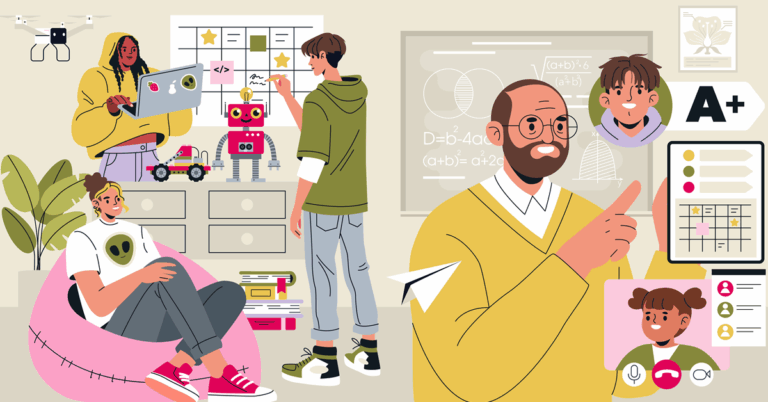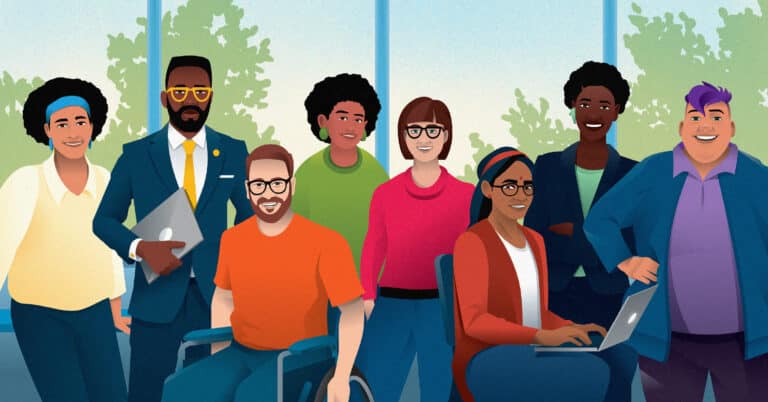This article was written by KnowledgeWorks consultant and former Senior Director of Strategic Initiatives Eric Toshalis, EdD and former Chief Learning Officer Virgel Hammonds.
There’s an essential truth we want more folks in education to recognize: tracking – the widespread practice of labeling, ranking, sorting and separating students, our children, by perceived academic ability and behavioral compliance – is bad, really bad. Its origins are racist and its current renditions in our schools perpetuate oppression and produce harm. The impact of tracking is particularly bad for students already facing multiple forms of injustice in and outside our schools. The data proving this fact are everywhere. That’s why we argued that when it comes to tracking, it’s inaccurate to say inequity is a symptom; it’s not really even an outcome. With tracking, inequity is a principle of design. The system is working as intended. That’s why we need to dismantle it.
Once folks begin to face this fact, they inevitably confront the difficult realization that if we’re to dismantle all the systems, policies, procedures and practices that compose tracking’s infrastructure, we’ll need to replace it with something else. That something needs to be a learning infrastructure ready to scale, ready to re-shape instruction and assessment, ready to shift mindsets, ready to inspire educators and students and parents and communities to rebuild learning environments so they prioritize belonging, growth, agency, self-efficacy, autonomy and cultural responsiveness.
Fortunately, that replacement infrastructure already exists.[/vc_column_text][/vc_column][/vc_row]
Personalized, competency-based learning replaces tracking
Those who lead and work within our schools often find it daunting to extricate themselves from traditional ways of “doing school” in part because many directly benefitted from those designs and because compelling alternatives to those approaches have yet to be presented. Many educators, leaders and parents cannot conceive of a school design that departs from separate and accelerated opportunities for “gifted” students, and isolated and remediated instruction for “struggling” learners. Needing to see it to believe it, some folks are reticent to abandon their cultural and professional training until they can be shown an alternative that offers more gain than loss. Even the most well-intentioned folks can be leery of accepting new ways of operating if they get stuck in old assumptions and problematic practices. We get that. Systemic change is hard. And changing beliefs can be even harder. But once we honestly and critically face what tracking is and what it does, we can’t ignore that we must do things differently and push through the reticence toward brighter horizons.
Here’s the good news: Those who have deeply investigated and implemented personalized, competency-based learning typically recognize that the rationale for tracking—and the practices and policies on which it depends—is soon stripped of its legitimacy. Once folks see how to keep students together socially and individualize instructional activities to build on the unique needs, assets and contributions each student possesses, tracking just doesn’t make sense anymore. It’s really this simple: schools don’t need to track once the logics and systemic practices of personalized, competency-based learning are established.
Want evidence for this? Twenty years ago, Oakes (1992) named three core challenges faced by those who sought to de-track schools:
- Normative challenges, based on long-standing beliefs that young persons differ by ability and that schools should be structured to address those differences
- Political challenges, reflecting the difficulty of overcoming vested interests in tracking, such as those held by parents who are ambitious for their high-achieving children and by teachers who enjoy teaching honors classes
- Technical challenges, reflecting the difficulty of instructing students of widely varying levels of performance, a task for which few school systems are prepared
Building on Oakes’ observation, Gamoran notes that most of the emphasis in de-tracking scholarship and strategies has been “on the normative and political challenges, reasoning that if these challenges could be surmounted, the technical difficulties could be easily overcome.” He notes, however, that evidence to the contrary has accumulated.
[F]ailure to solve the technical problems of mixed-ability teaching is a major impediment to addressing the normative and political challenges. While the technical challenges have defied easy solution, recent work has identified conditions under which effective teaching in mixed-ability contexts may be more successful than in the past.
We believe personalized, competency-based learning supplies necessary technical solutions to allow reformers to tackle both normative and political challenges. We also believe that if we do so we will be establishing the conditions for the achievement of equity.
For this reason and a bunch more, personalized, competency-based learning is ideally suited to become tracking’s replacement infrastructure and thereby function as an equity catalyst.
Ways tracking can and should be replaced by personalized, competency-based learning
Below we lay out a series of 13 comparisons to demonstrate how tracking can and should be replaced with personalized, competency-based learning. We consider this a starter list since there is likely a host of other comparisons and features likely worth surfacing—we hope you’ll reach out if you think of refinements and additions.
Download a printer-friendly PDF of the information below and share it with an educator, administrator, parent/guardian, community leader, student, district official and/or policymaker.
LOGIC
Tracking
Ability is innate, immutable, limits success.
Personalized, Competency-Based Learning
Mastery is incremental, achievable, unlimited.
STANDARD MODE OF OPERATION
Tracking
Use biased standardized tests and teacher recommendations to group and segregate students by perceived ability and behavioral compliance, then implement “one size fits all” pedagogies to try to reach and teach the bulk of learners in that track.
Personalized, Competency-Based Learning
Each student receives customized supports to remain engaged and challenged while mastering standards and aligned competencies. Personalized student supports allow for all students to be pushed to their potential, regardless of their current level of proficiency.
RESEARCH BASIS
Tracking
Eugenics, The Bell Curve, racism, classism, fixed notions of “intelligence,” segregation, apartheid, White supremacy.
Personalized, Competency-Based Learning
Agency, motivation, engagement, belonging, growth mindsets, self-determination theory, self-efficacy, expectancy-value theory, self-regulation, culturally-sustaining pedagogy, anti-oppressive pedagogy, border pedagogy, critical race theory, LatCrit, DisCrit, subtractive schooling, deeper learning, zone of proximal development, social learning theory.
MINDSET
Tracking
Fixed. Struggle is bad. It is evidence of insufficient ability, intelligence, commitment or preparedness for success. Struggle demonstrates what a student cannot do. If students struggle in an activity or content area, they may not be cut out for success in that domain. If students need to slow down or re-learn something, that demonstrates they are incapable of learning the material at the pace others may be learning it. Such students will be unlikely to catch up so they should be separated.
Personalized, Competency-Based Learning
Growth. Struggle is good. Struggle is evidence of the edge of the learner’s current competency. Struggle is encouraged not pathologized, and failure is understood to be part of the learning process. Improvement is assured with effort, help, resources, access and time. If a student needs to slow down or re-learn something, that’s normal and expected; it only demonstrates a need to differentiate the learning activity or temporarily change the pace. Students can catch up and take multiple paths toward mastery.
INTENTION
Tracking
Secure unearned advantage for over-resourced students and families. Rank and sort children and youth to provide justification for arbitrary and discriminatory social hierarchies. Provide ample supply of cheap unskilled labor and thereby maximize profits for the elite. Convince individuals that their socioeconomic position is an inevitable and natural consequence of their biology. Present schools as meritocracies.
Personalized, Competency-Based Learning
Establish meaningful and equitable opportunities to excel so all students are prepared to flourish in post-secondary college and career. Inspire mastery of content, commitment to lifelong learning, knowledge of how to learn and proficiency in 21st century skills. Democratize access to opportunity to stabilize schools, communities, the economy and our nation, and reduce status differences that drive social discord. Give all kids a chance at a bright future.
PURPOSE OF ASSESSMENT
Tracking
Assessment is for ranking and sorting. To prove which students merit “advanced” or “gifted” labels and which will be given an assortment of low-expectancy classifications (“low,” “struggling,” “college prep,” “honors,” etc.).
Personalized, Competency-Based Learning
Assessment is for learning. To capture what students can do now, and plan for what they will do next to keep growing in their competencies.
PATHWAYS
Tracking
Ruts to constrained if not pre-determined and foreclosed post-secondary college and career options.
Personalized, Competency-Based Learning
Personalized and open opportunities to explore interests, demonstrate growth and achieve forms of measurable mastery that are valued in post-secondary college and career settings.
PACING
Tracking
Keep up with the teacher’s or school’s arbitrary milestones or fall behind and either receive lowered grades, lose course credit or get diverted to lower tracks.
Personalized, Competency-Based Learning
Learners advance within the learning continua after demonstrating competency in ways that are meaningful, relevant and purposeful to each learner (examples of learning continua here). When utilizing learning continua, learning is the constant and time becomes the variable.
ENRICHMENT OPPORTUNITIES
Tracking
Only allocated for “gifted” learners.
Personalized, Competency-Based Learning
For all students, whenever they need them.
ACCELERATION OPPORTUNITIES
Tracking
Acceleration and enrichment for the ‘gifted’ few. Remediation and isolation for the rest.
Personalized, Competency-Based Learning
Acceleration and enrichment for all. Extra scaffolds, resources and instruction whenever needed.
WHAT GRADES SHOW
Tracking
Grades are threats. They are designed to scare students into completing work. They mostly measure student behaviors, students’ socioeconomic circumstances or their position within racial / gender / (dis)abled / linguistic hierarchies.
Personalized, Competency-Based Learning
Grades may be nonexistent, but if present reflect the level of mastery a student has achieved in a given domain of inquiry.
ETHIC
Tracking
You either have it or you don’t. Sink or swim. Compete against others to be “the best.”
Personalized, Competency-Based Learning
Everyone challenged, everyone supported, every day. Everyone working at the edges of their current and always expanding abilities. We lift as we rise. We collaborate with others to do our best and help others to do the same.
MEASURES
Tracking
Wide variability and bias in standardized assessments used to determine “ability,” plus ample evidence of racial / gender / class / linguistic / cultural bias in teacher recommendations used to determine placement. Parents with abundant social and cultural capital are more able to “game the system” to secure their child’s advantage which perpetuates the “rich get richer” outcomes intrinsic to tracking regimes. Little to no agreement of what constitutes an ‘A’ or a ‘B’ or a ‘C’ or ‘failing’ even among teachers who work in the same grade or department.
Personalized, Competency-Based Learning
Transparent and often teacher/student/family co-produced assessments of mastery aligned with curriculum standards set by the state, some of which have established levels of validity and reliability that permit scaling.
We believe that each learner must have access to the tools, supports and experiences needed to graduate ready for what’s next. Tracking is anathema to this goal. Personalized, competency-based learning, however, establishes engaging educational experiences that are customized to each learner’s strengths, needs, interests and funds of knowledge. In a personalized, competency-based learning environment, students have voice in and ownership over how, what, when and where they learn and connections to community and real-world experiences are a priority.
In a personalized, competency-based learning environment, students learn actively using different pathways and varied pacing that does not result in tracking or other forms of ability grouping. Each of these core elements of personalized, competency-based education—engaging experiences, a focus on the learner’s individual needs and assets, student agency and autonomy, connections to real-world experiences and preparation and de-tracking—have a substantial body of research and evidence supporting their efficacy in closing opportunity gaps and producing more equitable outcomes. And because personalized, competency-based learning can be used to dismantle and replace the racist origins of and current harms produced by tracking, it functions as a scalable, student-centered remedy. Let’s do this!
So what’s next?
- Download the table and share it with an educator, administrator, parent/guardian, community leader, student, district official and/or policymaker and ask to discuss its implications with them.
- What do members of your community say when they explain that de-tracking can’t be done in your neck of the woods? What reasons do they offer for why “it can’t be done here”? Which items in the table above might help them to see a way forward, to commit to de-tracking?
Sign up for the KnowledgeWorks newsletter to get the next articles and associated resources in this series.






